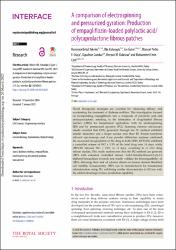| dc.contributor.author | Yekeler, Hümeyra Betül | |
| dc.contributor.author | Kabaoğlu, İlke | |
| dc.contributor.author | Güler, Ece | |
| dc.contributor.author | Graça, Manuel Pedro F. | |
| dc.contributor.author | Gündüz, Oğuzhan | |
| dc.contributor.author | Kalaskar, Deepak M. | |
| dc.contributor.author | Çam, Muhammet Emin | |
| dc.date.accessioned | 2025-03-27T06:50:49Z | |
| dc.date.available | 2025-03-27T06:50:49Z | |
| dc.date.issued | 2025 | en_US |
| dc.identifier.citation | Yekeler HB, Kabaoglu I, Guler E, Graça MPF, Gunduz O, Kalaskar DM, Cam ME. 2025 A comparison of electrospinning and pressurized gyration: Production of empagliflozin-loaded polylactic acid/polycaprolactone fibrous patches. J. R. Soc. Interface 22: 20240635. | en_US |
| dc.identifier.issn | 1742-5662 | |
| dc.identifier.uri | https://royalsocietypublishing.org/doi/10.1098/rsif.2024.0635 | |
| dc.identifier.uri | https://doi.org/10.1098/rsif.2024.0635 | |
| dc.identifier.uri | https://hdl.handle.net/20.500.12780/1060 | |
| dc.description.abstract | Novel therapeutic strategies are essential for enhancing efficacy and
accelerating the treatment of diabetes mellitus. This investigation focused
on incorporating empagliflozin into a composite of polylactic acid and
polycaprolactone, resulting in the fabrication of drug-loaded fibrous
patches (DFPs) for transdermal application, both by electrospinning
(ES) and by pressurized gyration (PG). Scanning electron microscopy
results revealed that DFPs generated through the PG method exhibited
smaller diameters and a larger surface area than ES. Fourier-transform
infrared spectroscopy and X-ray powder diffraction analyses confirmed
the successful encapsulation of the drug in both DFPs. DFPs/PG exhibited
a controlled release of 98.7 ± 1.3% of the total drug over 14 days, while
DFPs/ES released 98.1 ± 2.1% in 12 days, according to in vitro drug
release studies. This study underscores that the PG method can generate
DFPs with extended controlled release. 3-(4,5-dimethylthiazol-2-yl)-2,5
diphenyl tetrazolium bromide test results validate the biocompatibility of
DFPs, affirming their lack of adverse effects on human dermal fibroblast
cell viability. Consequently, DFPs can be manufactured for transdermal
administration using PG, exhibiting similar characteristics to ES but with
the added advantage of mass production capability. | en_US |
| dc.language.iso | eng | en_US |
| dc.publisher | Royal Soc | en_US |
| dc.relation.isversionof | 10.1098/rsif.2024.0635 | en_US |
| dc.rights | info:eu-repo/semantics/openAccess | en_US |
| dc.subject | type 2 diabetes mellitus | en_US |
| dc.subject | empagliflozin | en_US |
| dc.subject | electrospinning | en_US |
| dc.subject | pressurized gyration | en_US |
| dc.subject | transdermal | en_US |
| dc.title | A comparison of electrospinning and pressurized gyration: Production of empagliflozin-loaded polylactic acid/ polycaprolactone fibrous patches | en_US |
| dc.type | article | en_US |
| dc.contributor.department | İstanbul Kent Üniversitesi, Fakülteler, Eczacılık Fakültesi, Eczacılık Meslek Bilimleri Bölümü | en_US |
| dc.contributor.authorID | 0000-0002-0639-5029 | en_US |
| dc.contributor.authorID | 0000-0001-5398-6801 | en_US |
| dc.contributor.institutionauthor | Güler, Ece | |
| dc.contributor.institutionauthor | Çam, Muhammet Emin | |
| dc.identifier.volume | 22 | en_US |
| dc.identifier.issue | 224 | en_US |
| dc.relation.journal | Journal of The Royal Society Interface | en_US |
| dc.relation.publicationcategory | Makale - Uluslararası Hakemli Dergi - Kurum Öğretim Elemanı | en_US |


















